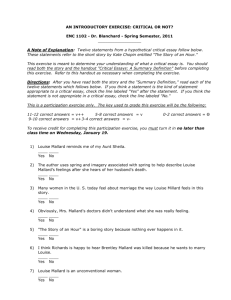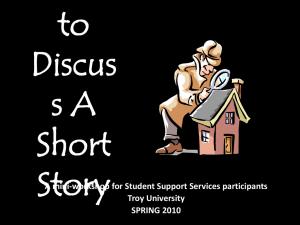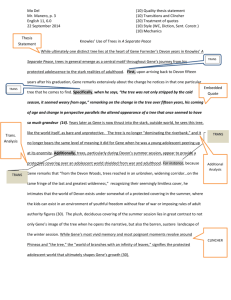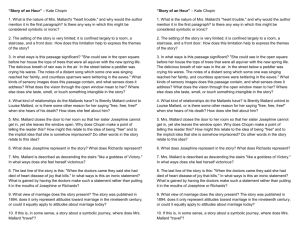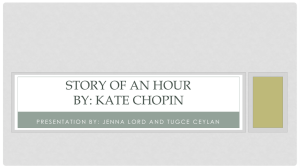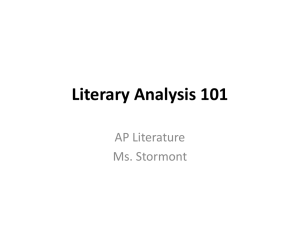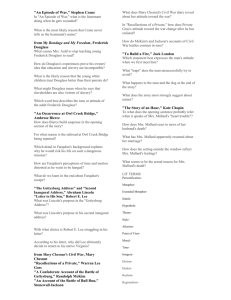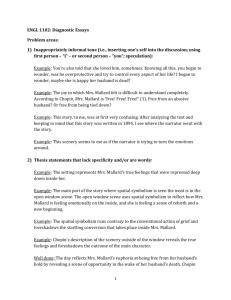ENGL 1102-29
advertisement
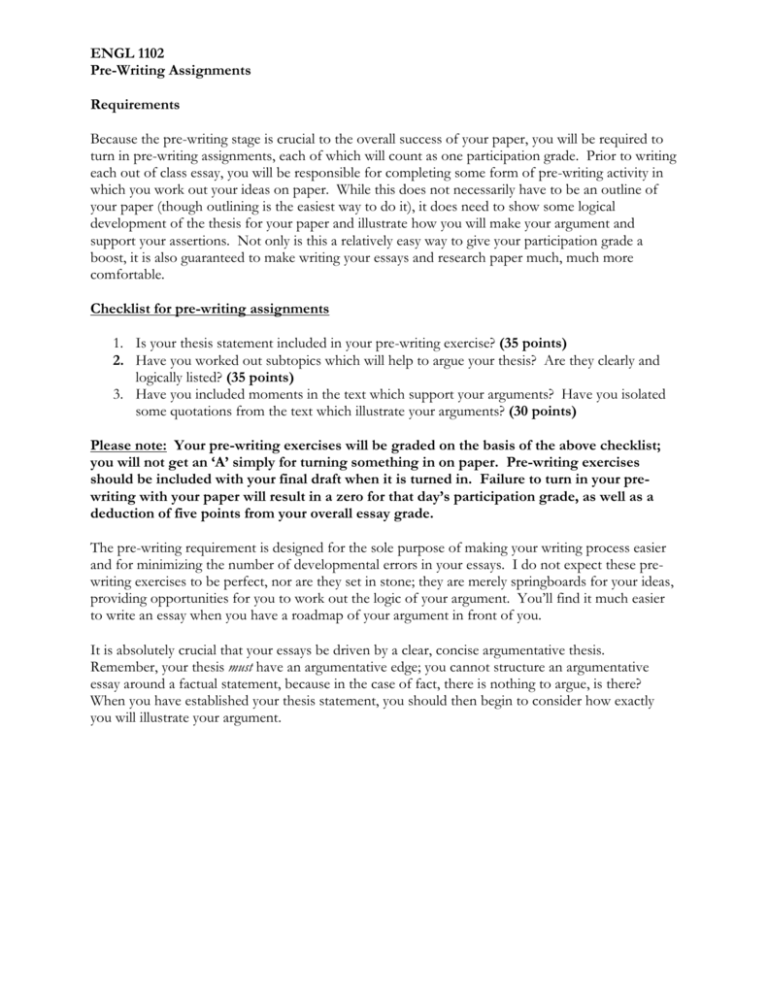
ENGL 1102 Pre-Writing Assignments Requirements Because the pre-writing stage is crucial to the overall success of your paper, you will be required to turn in pre-writing assignments, each of which will count as one participation grade. Prior to writing each out of class essay, you will be responsible for completing some form of pre-writing activity in which you work out your ideas on paper. While this does not necessarily have to be an outline of your paper (though outlining is the easiest way to do it), it does need to show some logical development of the thesis for your paper and illustrate how you will make your argument and support your assertions. Not only is this a relatively easy way to give your participation grade a boost, it is also guaranteed to make writing your essays and research paper much, much more comfortable. Checklist for pre-writing assignments 1. Is your thesis statement included in your pre-writing exercise? (35 points) 2. Have you worked out subtopics which will help to argue your thesis? Are they clearly and logically listed? (35 points) 3. Have you included moments in the text which support your arguments? Have you isolated some quotations from the text which illustrate your arguments? (30 points) Please note: Your pre-writing exercises will be graded on the basis of the above checklist; you will not get an ‘A’ simply for turning something in on paper. Pre-writing exercises should be included with your final draft when it is turned in. Failure to turn in your prewriting with your paper will result in a zero for that day’s participation grade, as well as a deduction of five points from your overall essay grade. The pre-writing requirement is designed for the sole purpose of making your writing process easier and for minimizing the number of developmental errors in your essays. I do not expect these prewriting exercises to be perfect, nor are they set in stone; they are merely springboards for your ideas, providing opportunities for you to work out the logic of your argument. You’ll find it much easier to write an essay when you have a roadmap of your argument in front of you. It is absolutely crucial that your essays be driven by a clear, concise argumentative thesis. Remember, your thesis must have an argumentative edge; you cannot structure an argumentative essay around a factual statement, because in the case of fact, there is nothing to argue, is there? When you have established your thesis statement, you should then begin to consider how exactly you will illustrate your argument. Below is a rough example of what your pre-writing assignments should look like. The following pre-writing is not fully detailed, but it should give you some idea of where to begin. (This example follows the traditional three-point essay structure, but you are not restricted to following this format.) Thesis statement: Chopin effectively illustrates the breadth of Louise Mallard’s emotions in the wake of the news of her husband’s death, from her initial pangs of grief, to her bewildering sense of joy, and finally to her exhilarated awareness of sudden freedom. Through Louise Mallard’s transformation from repressed wife to liberated widow, Chopin critiques the oppression inherent in marriage for wives at the turn of the century. 1. Characterization of Louise as a grieving widow: *Topic sentence: In the early scenes of the story, Chopin emphasizes Louise Mallard’s position as a grieving widow. Examples from the text to support this characterization/analysis: a. We’re told that she weeps “at once” (76) when she hears the news of her husband’s death. (Louise’s reaction indicates that she immediately feels the loss of her husband.) b. After Mrs. Mallard goes to her room to be alone, Chopin describes her grief poignantly, likening her deep sadness to that of a child: “She sat with her head thrown back upon the cushion of the chair, quite motionless, except when a sob came up into her throat and shook her, as a child who has cried itself to sleep continues to sob in its dreams” (77). (Likening Mrs. Mallard to a devastated child makes her appear more vulnerable, and so we are moved to sympathize with her.) c. One of the only physical descriptions that Chopin gives us of Mrs. Mallard notes the fact that she is young, but her face is lined with wrinkles that speak of “repression and even a certain strength” (77). (Here Chopin draws attention to the fact that Mrs. Mallard has lived a difficult life; the word “repression” indicates that she has not felt the freedom to express herself.) 2. Louise Mallard’s bewildering “monstrous joy”: *Topic sentence: Louise’s grief soon turns to “monstrous joy” as she struggles to reconcile her bewildering sense of relief intermingled with the devastation of her loss; Chopin expresses these contradictory emotions through using language resonant of rebirth to describe the setting, while at the same time noting Louise’s initial resistance to (and fear of) such new emotions. a. a. Mrs. Mallard looks out the window onto a beautiful spring day, and Chopin’s description very pointedly echoes a sense of rebirth, rejuvenation, and happiness; later, we’re told that Mrs. Mallard feels something “coming to her” (77), and that she waits for it “fearfully” (77). Chopin goes on to describe the “something” as “creeping out of the sky, reaching toward her through the sounds, the scents, the color that filled the air” (77). 2 (The fact that Mrs. Mallard feels fearful indicates that perhaps something still holds her back, while Chopin’s emphasis on the “sounds, the scents, the colors” clearly evokes a kind of sensuality or reawakening, particularly in light of the description of the spring-like scene outside the window.) b. Chopin says that Mrs. Mallard starts to “recognize this thing that was approaching to possess her, and she was striving to beat it back with her will – as powerless as her two white slender hands would have been” (77-8). (She’s recognizing that what she’s starting to feel is a sense of rejuvenation, and she’s resistant to it, but ultimately is unable to repress the feelings that take over her. The fact that she strives to resist her feelings indicates that she’s still struggling to let go of her sense of obligation to her husband.) 3. Louise Mallard as a liberated woman: *Topic sentence: Finally, Louise’s transformation is complete, as she consciously welcomes the years to come, in which she will “live for herself” (78), as opposed to living under the oppression of her husband. a. Mrs. Mallard muses that she will “live for herself” (78) in the years to come. (The fact that she’ll now be able to live for herself indicates that throughout her marriage, she lived for her husband, putting her own needs behind his.) b. Chopin also notes that, “There would be no powerful will bending hers in that blind persistence with which men and women believe they have a right to impose a private will upon a fellow creature” (78). Directly following this statement, she refers to Louise’s awareness “in a moment of illumination” that such behavior is “a crime” (78). (Chopin’s use of the word “crime” in reference to Mr. Mallard’s treatment of his wife clearly emphasizes that Mrs. Mallard has up to this point been a victim. Referring to Mrs. Mallard’s awareness of this fact as a moment of “illumination” indicates that she has evolved, gone through a transformation.) c. We’re told that Mrs. Mallard “breathed a quick prayer that life might be long. It was only yesterday that she had though with a shudder that life might be long” (79). (Obviously, Mrs. Mallard’s sudden desire for a long life (in the wake of her husband’s death, when the previous day – when her husband was alive – she dreaded the possibility of a long life) indicates that she feels liberated and alive. For her to think with a “shudder” that life might be long while her husband was alive further emphasizes the fact that she must have felt oppressed and stifled within the confines of her marriage.) 3 Quick Reference Outline: I. Introductory Paragraph 1. Hook (see handbook pg. 52 / 8d for suggestions) 2. Background information 3. Thesis statement II. Body Paragraph I 1. 2. 3. 4. Topic sentence Support statement Example(s) Conclusion/transition to next point III. Body Paragraph II 1. 2. 3. 4. Topic sentence Support statement Example(s) Conclusion/transition to next point IV. Body Paragraph III 1. 2. 3. 4. Topic sentence Support statement Example (s) Conclusion/transition to next point V. Conclusion 1. Reference to introduction or summarize main point (see handbook pg. 53/8d for suggestions) 2. Restatement of thesis argument 3. Reaffirmation of supporting evidence 4. Conclusion 4
